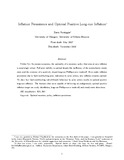| dc.contributor.author | Pontiggia, Dario | |
| dc.date.accessioned | 2015-12-16T10:33:04Z | |
| dc.date.available | 2015-12-16T10:33:04Z | |
| dc.date.issued | 2007 | |
| dc.identifier.uri | http://hdl.handle.net/11728/6660 | |
| dc.description.abstract | Within New Keynesian economics, the optimality of a monetary policy that aims at zero inflation is surprisingly robust. Optimal monetary policy has this character despite the inefficiency of the nonstochastic steady state and despite the existence of a positively sloped long-run Phillips-curve trade-off. Full price stability remains optimal even under inflation persistence due to backward-looking price indexation by price setters. We show how extending a basic New Keynesian model to the case of inflation persistence due to backward-looking rule-of-thumb behaviour by price setters breaks the surprising robustness of zero long-run inflation target, namely backward-looking rule-of-thumb behaviour by price setters results in optimal positive long-run inflation. Comparing different theoretical explanations for structural inflation persistence suggests that the features that seem capable of delivering an endogenously optimal inflation target are costly disinflation, long-run Phillips-curve trade-off, and steady-state distortions. | en_UK |
| dc.language.iso | en | en_UK |
| dc.rights.uri | http://creativecommons.org/licenses/by-nc-nd/4.0/ | en_UK |
| dc.source.uri | https://mpra.ub.uni-muenchen.de/id/eprint/3677 | en_UK |
| dc.subject | Optimal monetary policy | en_UK |
| dc.subject | Inflation persistence | en_UK |
| dc.title | Inflation persistence and optimal positive long-run inflation | en_UK |
| dc.type | Article | en_UK |


